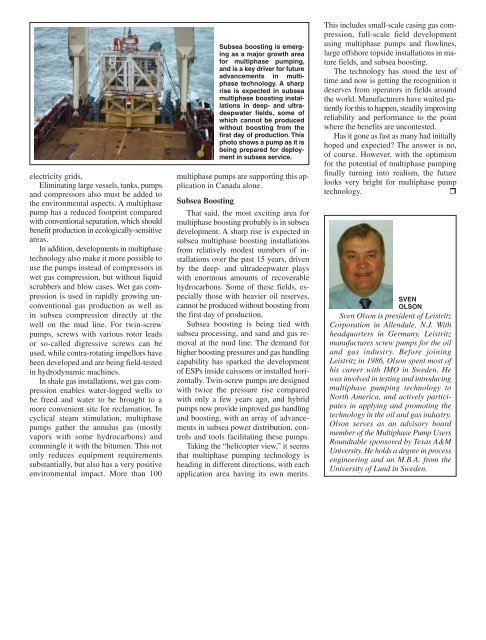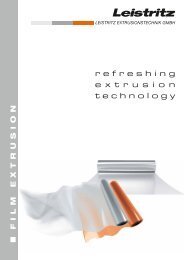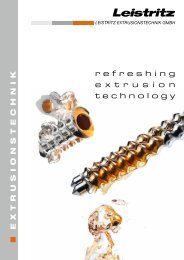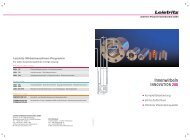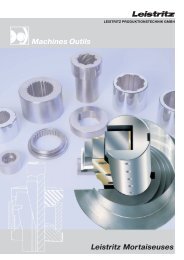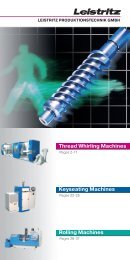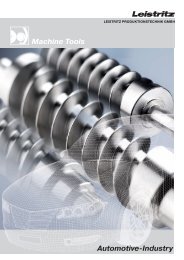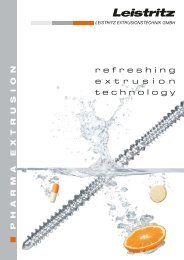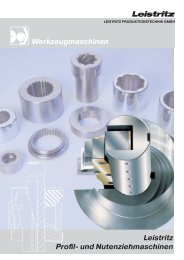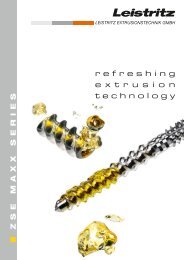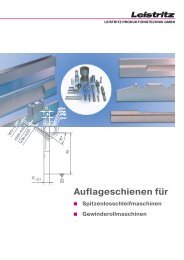und Messespiegel 1/2012 - Leistritz AG
und Messespiegel 1/2012 - Leistritz AG
und Messespiegel 1/2012 - Leistritz AG
Create successful ePaper yourself
Turn your PDF publications into a flip-book with our unique Google optimized e-Paper software.
electricity grids.<br />
Eliminating large vessels, tanks, pumps<br />
and compressors also must be added to<br />
the environmental aspects. A multiphase<br />
pump has a reduced footprint compared<br />
with conventional separation, which should<br />
benefit production in ecologically-sensitive<br />
areas.<br />
In addition, developments in multiphase<br />
technology also make it more possible to<br />
use the pumps instead of compressors in<br />
wet gas compression, but without liquid<br />
scrubbers and blow cases. Wet gas compression<br />
is used in rapidly growing unconventional<br />
gas production as well as<br />
in subsea compression directly at the<br />
well on the mud line. For twin-screw<br />
pumps, screws with various rotor leads<br />
or so-called digressive screws can be<br />
used, while contra-rotating impellors have<br />
been developed and are being field-tested<br />
in hydrodynamic machines.<br />
In shale gas installations, wet gas compression<br />
enables water-logged wells to<br />
be freed and water to be brought to a<br />
more convenient site for reclamation. In<br />
cyclical steam stimulation, multiphase<br />
pumps gather the annulus gas (mostly<br />
vapors with some hydrocarbons) and<br />
commingle it with the bitumen. This not<br />
only reduces equipment requirements<br />
substantially, but also has a very positive<br />
environmental impact. More than 100<br />
Subsea boosting is emerging<br />
as a major growth area<br />
for multiphase pumping,<br />
and is a key driver for future<br />
advancements in multiphase<br />
technology. A sharp<br />
rise is expected in subsea<br />
multiphase boosting installations<br />
in deep- and ultradeepwater<br />
fields, some of<br />
which cannot be produced<br />
without boosting from the<br />
first day of production. This<br />
photo shows a pump as it is<br />
being prepared for deployment<br />
in subsea service.<br />
multiphase pumps are supporting this application<br />
in Canada alone.<br />
Subsea Boosting<br />
That said, the most exciting area for<br />
multiphase boosting probably is in subsea<br />
development. A sharp rise is expected in<br />
subsea multiphase boosting installations<br />
from relatively modest numbers of installations<br />
over the past 15 years, driven<br />
by the deep- and ultradeepwater plays<br />
with enormous amounts of recoverable<br />
hydrocarbons. Some of these fields, especially<br />
those with heavier oil reserves,<br />
cannot be produced without boosting from<br />
the first day of production.<br />
Subsea boosting is being tied with<br />
subsea processing, and sand and gas removal<br />
at the mud line. The demand for<br />
higher boosting pressures and gas handling<br />
capability has sparked the development<br />
of ESPs inside caissons or installed horizontally.<br />
Twin-screw pumps are designed<br />
with twice the pressure rise compared<br />
with only a few years ago, and hybrid<br />
pumps now provide improved gas handling<br />
and boosting, with an array of advancements<br />
in subsea power distribution, controls<br />
and tools facilitating these pumps.<br />
Taking the “helicopter view,” it seems<br />
that multiphase pumping technology is<br />
heading in different directions, with each<br />
application area having its own merits.<br />
This includes small-scale casing gas compression,<br />
full-scale field development<br />
using multiphase pumps and flowlines,<br />
large offshore topside installations in mature<br />
fields, and subsea boosting.<br />
The technology has stood the test of<br />
time and now is getting the recognition it<br />
deserves from operators in fields aro<strong>und</strong><br />
the world. Manufacturers have waited patiently<br />
for this to happen, steadily improving<br />
reliability and performance to the point<br />
where the benefits are uncontested.<br />
Has it gone as fast as many had initially<br />
hoped and expected? The answer is no,<br />
of course. However, with the optimism<br />
for the potential of multiphase pumping<br />
finally turning into realism, the future<br />
looks very bright for multiphase pump<br />
technology. r<br />
SVEN<br />
OLSON<br />
Sven Olson is president of <strong>Leistritz</strong><br />
Corporation in Allendale, N.J. With<br />
headquarters in Germany, <strong>Leistritz</strong><br />
manufactures screw pumps for the oil<br />
and gas industry. Before joining<br />
<strong>Leistritz</strong> in 1986, Olson spent most of<br />
his career with IMO in Sweden. He<br />
was involved in testing and introducing<br />
multiphase pumping technology to<br />
North America, and actively participates<br />
in applying and promoting the<br />
technology in the oil and gas industry.<br />
Olson serves as an advisory board<br />
member of the Multiphase Pump Users<br />
Ro<strong>und</strong>table sponsored by Texas A&M<br />
University. He holds a degree in process<br />
engineering and an M.B.A. from the<br />
University of L<strong>und</strong> in Sweden.


